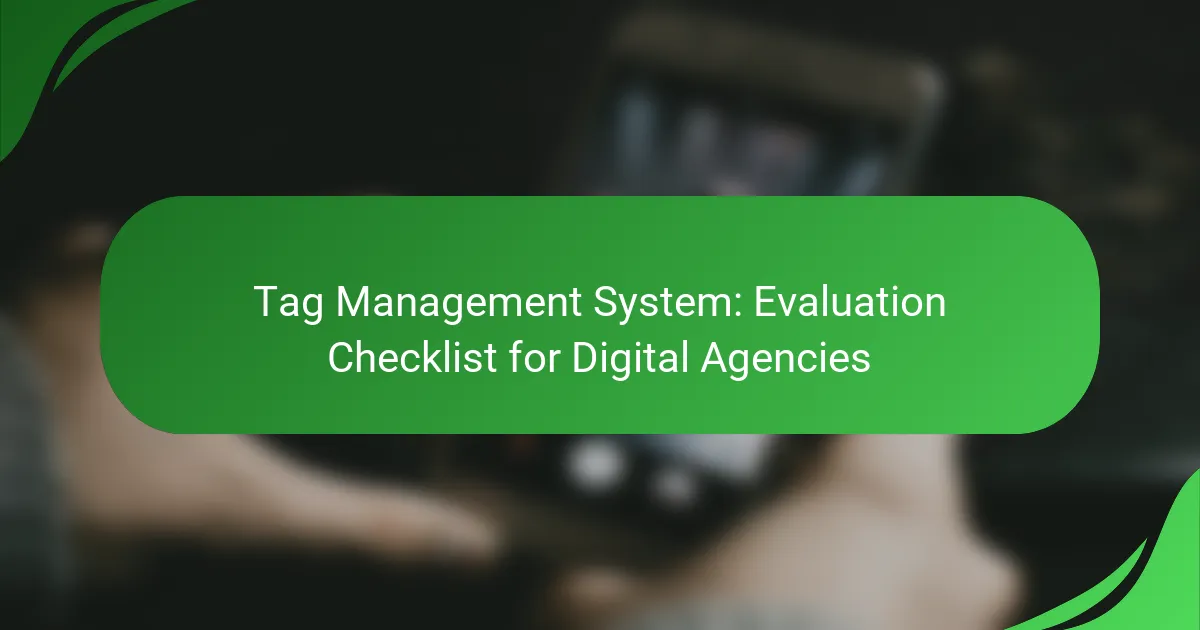For large enterprises, choosing the right tag management system (TMS) is crucial for optimizing marketing efforts and ensuring compliance with regulations. The best TMS options offer scalability, robust features, and user-friendly interfaces, enabling organizations to efficiently manage tags and enhance website performance. By simplifying the deployment process, these systems empower marketers to launch campaigns quickly while maintaining data privacy and security.

What are the best tag management systems for large enterprises in Canada?
The best tag management systems (TMS) for large enterprises in Canada include solutions that provide robust features, scalability, and compliance with local regulations. These systems help organizations efficiently manage marketing tags and improve website performance while ensuring data privacy and security.
Google Tag Manager
Google Tag Manager (GTM) is a widely used tag management solution that allows enterprises to manage and deploy marketing tags without modifying the code directly. It offers a user-friendly interface, making it easy for marketing teams to implement tracking codes quickly.
GTM supports a variety of tags, including those for Google Analytics, AdWords, and third-party services. It also provides built-in templates and triggers to streamline tag deployment. However, enterprises should ensure they have adequate training to avoid misconfigurations that could lead to data inaccuracies.
Adobe Experience Platform Launch
Adobe Experience Platform Launch is a powerful tag management system designed for enterprises that require advanced capabilities and integration with Adobe’s suite of marketing tools. It allows users to manage tags, data elements, and rules in a flexible environment.
This platform supports a wide range of third-party integrations and offers features like automated updates and version control. Organizations should consider the learning curve associated with its advanced functionalities, which may require dedicated resources for effective implementation.
Tealium iQ Tag Management
Tealium iQ Tag Management is known for its enterprise-level capabilities, including extensive integrations and real-time data management. It provides a centralized platform for managing tags across multiple digital properties, ensuring consistency and accuracy in data collection.
Tealium’s features include audience segmentation and data enrichment, which can enhance marketing strategies. However, enterprises should evaluate the cost, as it may be higher compared to other options, depending on the scale of usage and required features.
Ensighten
Ensighten is a tag management system that focuses on data privacy and security, making it suitable for enterprises that handle sensitive information. It offers features like real-time data governance and compliance management, which are crucial for organizations in regulated industries.
This platform allows for seamless integration with various marketing technologies and provides robust reporting capabilities. Enterprises should assess their specific compliance needs to leverage Ensighten’s strengths effectively.
Signal
Signal is a tag management solution that emphasizes customer data integration and real-time analytics. It enables enterprises to unify their data across different channels, providing a comprehensive view of customer interactions.
Signal’s features include audience segmentation and personalized marketing capabilities, which can enhance customer engagement. Organizations should consider their existing data infrastructure to ensure compatibility and maximize the benefits of using Signal.

How do tag management systems improve marketing efficiency?
Tag management systems (TMS) enhance marketing efficiency by simplifying the process of managing and deploying tags across digital platforms. They allow marketers to quickly implement changes without needing extensive technical support, leading to faster campaign launches and improved data collection.
Streamlined tag deployment
Streamlined tag deployment enables marketing teams to add, edit, or remove tags without relying on IT resources. This agility allows for rapid testing of marketing strategies and quicker adaptations to market changes. For instance, a marketing team can implement a new tracking tag in minutes rather than days, significantly accelerating campaign timelines.
To ensure effective deployment, it’s crucial to maintain a clear tagging structure and documentation. This helps avoid conflicts and ensures that all team members understand the tagging strategy.
Enhanced data accuracy
Enhanced data accuracy is achieved by centralizing tag management, which reduces the likelihood of errors that can occur with manual coding. A TMS can automatically validate tags and ensure they are firing correctly, leading to more reliable data collection and analysis. For example, using a TMS can decrease discrepancies in conversion tracking by ensuring that all relevant tags are consistently applied across pages.
Marketers should regularly audit their tags to maintain data integrity. Setting up automated alerts for tag performance can help identify issues before they impact data quality.
Faster website performance
Faster website performance is a key benefit of using a tag management system, as it minimizes the load time associated with multiple tags. A TMS can asynchronously load tags, allowing the main content of a webpage to render without delay. This can lead to improved user experience and potentially higher conversion rates.
To optimize website performance, prioritize essential tags and consider using a tag sequencing strategy to load them in the most efficient order. Regularly reviewing and cleaning up unused tags can also help maintain speed.

What criteria should be considered when choosing a tag management system?
When selecting a tag management system (TMS), enterprises should prioritize integration capabilities, scalability, and user-friendliness. These factors ensure that the TMS can seamlessly fit into existing workflows, accommodate growth, and be easily navigated by team members.
Integration capabilities
Integration capabilities are crucial for a TMS, as they determine how well the system connects with other marketing and analytics tools. Look for a TMS that supports a wide range of integrations, including popular platforms like Google Analytics, Adobe Experience Cloud, and various CRM systems.
Consider whether the TMS offers pre-built connectors or APIs for custom integrations. A robust integration framework can save time and reduce errors, allowing for smoother data flow across systems.
Scalability for enterprise needs
Scalability is essential for large enterprises that expect to grow and evolve. A TMS should handle increasing volumes of data and support a growing number of tags without compromising performance. Evaluate how the system performs under high traffic and whether it can manage multiple domains or subdomains efficiently.
Additionally, consider the pricing model; some TMS solutions charge based on the number of tags or users, which can impact costs as your enterprise scales. Choose a system that aligns with your long-term growth strategy.
User-friendly interface
A user-friendly interface is vital for ensuring that team members can effectively utilize the TMS without extensive training. Look for a TMS that offers an intuitive dashboard, drag-and-drop functionality, and clear documentation to facilitate ease of use.
Consider conducting a trial or demo to assess the interface. A system that is easy to navigate can lead to faster implementation and better adoption across your organization, ultimately maximizing the value of your tag management efforts.

How do pricing models vary among tag management systems?
Pricing models for tag management systems (TMS) can differ significantly, impacting how enterprises budget for these tools. Understanding the various pricing structures helps organizations choose a solution that aligns with their needs and financial constraints.
Subscription-based pricing
Subscription-based pricing is a common model where enterprises pay a recurring fee, typically monthly or annually, for access to the TMS. This model often includes different tiers based on the number of users, features, or data volume, allowing companies to select a plan that fits their size and usage. For example, a small business might pay a few hundred dollars per month, while larger enterprises could face costs in the thousands.
When considering subscription-based pricing, organizations should evaluate the total cost of ownership, including any additional fees for support or advanced features. It’s essential to assess whether the subscription aligns with the expected return on investment.
Tiered pricing structures
Tiered pricing structures offer multiple levels of service at different price points, catering to businesses of varying sizes and needs. Each tier typically includes a set of features, with higher tiers providing more advanced capabilities such as enhanced analytics or increased user access. For instance, a basic tier might start around $500 per month, while premium tiers could exceed $2,000.
Enterprises should carefully analyze the features included in each tier to ensure they are not overpaying for unnecessary capabilities. Additionally, understanding the scalability of these tiers is crucial, as businesses may need to upgrade as they grow.
Free vs. paid options
Many tag management systems offer free versions with limited features, which can be a good starting point for small businesses or those new to TMS. However, free options often lack essential functionalities, such as advanced reporting or integrations, which may hinder larger enterprises. Paid options typically provide a more comprehensive suite of tools and support.
When evaluating free versus paid options, organizations should consider their long-term needs and whether the limitations of free tools will impact their marketing efforts. Investing in a paid solution may yield better results and efficiencies in the long run.

What are the common challenges faced by enterprises using tag management systems?
Enterprises using tag management systems often encounter challenges such as data privacy compliance, tag bloat, and complexities in cross-domain tracking. Addressing these issues is crucial for optimizing performance and ensuring regulatory adherence.
Data privacy compliance
Data privacy compliance is a significant challenge for enterprises, especially with regulations like GDPR and CCPA. Companies must ensure that their tag management systems do not inadvertently collect personal data without consent, which can lead to hefty fines and reputational damage.
To navigate these regulations, enterprises should implement robust consent management frameworks within their tag management systems. Regular audits and updates to privacy policies are also essential to maintain compliance and build customer trust.
Tag bloat issues
Tag bloat occurs when an excessive number of tags are implemented, leading to slower page load times and degraded user experience. This can negatively impact site performance and SEO rankings, making it crucial for enterprises to manage their tags effectively.
To mitigate tag bloat, enterprises should regularly review and prioritize their tags, removing any that are redundant or underperforming. Utilizing a centralized tag management system can help streamline this process and ensure that only necessary tags are active.
Cross-domain tracking complexities
Cross-domain tracking can be complicated due to the need to maintain user sessions and data consistency across multiple domains. This is particularly challenging for enterprises with extensive online ecosystems, as improper implementation can lead to fragmented user data.
To simplify cross-domain tracking, enterprises should adopt standardized protocols and ensure that their tag management systems are configured to handle session stitching effectively. Regular testing and validation of tracking setups across domains can help identify and resolve issues promptly.

How can enterprises optimize their tag management strategies?
Enterprises can optimize their tag management strategies by implementing a centralized tag management system (TMS) that allows for efficient control and deployment of tags across various platforms. This approach enhances data accuracy, improves website performance, and simplifies compliance with regulations.
Evaluate your current tagging needs
Start by assessing your existing tagging requirements. Identify which tags are essential for tracking user behavior, marketing performance, and compliance. This evaluation helps prioritize tags based on their impact on business objectives.
Consider factors such as the volume of traffic, types of data collected, and integration with existing marketing tools. A clear understanding of your tagging needs will guide the selection of a suitable TMS.
Choose the right tag management system
Selecting the appropriate tag management system is crucial for optimizing your strategy. Look for features such as user-friendly interfaces, robust security measures, and seamless integration with analytics and marketing platforms.
Popular options for large enterprises include Google Tag Manager, Adobe Launch, and Tealium. Each offers unique functionalities, so evaluate them based on your specific requirements and budget.
Implement governance and compliance measures
Establish governance protocols to ensure proper tag management and compliance with data protection regulations like GDPR or CCPA. Define roles and responsibilities for tag creation, modification, and deletion to maintain control over data collection practices.
Regular audits of tags and their performance can help identify outdated or redundant tags, ensuring that your tagging strategy remains efficient and compliant.
Train your team
Invest in training for your team to maximize the effectiveness of your tag management system. Ensure that team members understand how to use the TMS effectively and are aware of best practices for tag implementation and data analysis.
Consider creating documentation and resources that outline processes and guidelines for tag management. This will help maintain consistency and efficiency across your organization.
Monitor and optimize performance
Continuously monitor the performance of your tags to identify areas for improvement. Use analytics tools to track the impact of tags on website performance and user engagement.
Regularly review and optimize your tagging strategy based on performance data. This iterative process ensures that your tag management remains aligned with business goals and adapts to changing market conditions.



